MnDOT Innovation Focus
 Note from MnDOT’s Innovation Director
By Katie Walker, MnDOT’s Director of Research & Innovation

Welcome to the summer issue of our innovation newsletter! This past month, I had the opportunity to connect and share with fellow DOTs at AASHTO’s National Research Advisory Committee meeting in Columbus, Ohio. I presented on our recently published 2023-2027 Minnesota Department of Transportation Research Strategic Plan, this plan establishes a research vision, mission, guiding principle, and six strategic goals to guide our research through 2027. Additionally, I introduced MnDOT and the LRRB’s new framework for framework for benefit evaluation—designed to help understand the outcomes of our investment in research and innovation, promote further exploration and implementation of new knowledge and technology in transportation, and prioritize future research and implementation project.
Sending big kudos to all the award winners recognized at the event! Two MnDOT research projects (Implementation of Lane Boundary Guidance System for Snowplow Operations and Influence of Autonomous and Partially Autonomous Vehicles on Minnesota Roads) received AASHTO’s High Value Research awards and Clear Roads, a MnDOT-led pooled fund, won the Transportation Pooled Fund Excellence award.
Lastly, it was energizing to learn about the innovations being led by our partner transportation departments! I encourage you to check out Drive Ohio, preparing Ohio’s talent for the future with a portfolio of workforce development programs, from Pre-K to PhD. In their Vertiport Innovation Challenge, they offered high schools and higher education institutions opportunities to participate in an advanced air mobility challenge, resulting in creative technology innovations.
|
Learning Through Failure, Empowering MnDOT Staff to Take Calculated Risks
By Kerrie Workman, Innovation Coordinator
MnDOT’s Office of Research & Innovation hosted an Innovation Hour, focused on empowerment, on June 14. During the session, attendees learned about the E3 Mindset, the six building blocks of an innovative culture, and the role empowerment plays in innovation. MnDOT panelists, including Adam Ahrndt (District 3), Kayla Dean (Communications and Public Engagement), and Marilee Tuite (Library) shared their experiences with empowerment at work.
Take a look inside the Museum of Failure, a museum in Sweden that explores history’s biggest failed products. Founded by Samuel West, the museum is meant to teach its visitors about innovation and learning through failure.
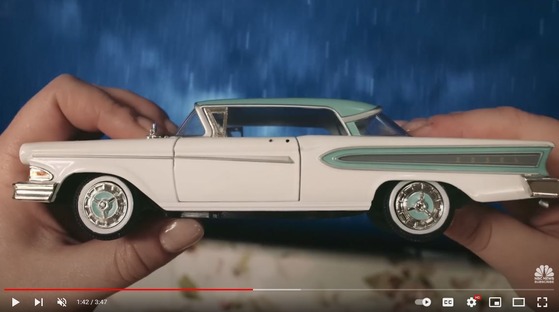 Looking for more? Check out previous Innovation Hours:
Maintenance Innovations Keep MnDOT Moving, Demo Days in Detroit Lakes
By Anne Meyer, Media Relations

It was a great turnout in District 4 in late June for Demo Days at the Kent Freeman Hockey Arena/Becker County Fairgrounds in Detroit Lakes. This every-other-year event showcases some of the latest maintenance equipment and techniques.
This year crews got to see equipment to help increase brine and liquid capacity during snow and ice operations, improve safety for guardrail repair and items related to managing roadsides. The next Demo Days event will be hosted by District 7 in Mankato.
|
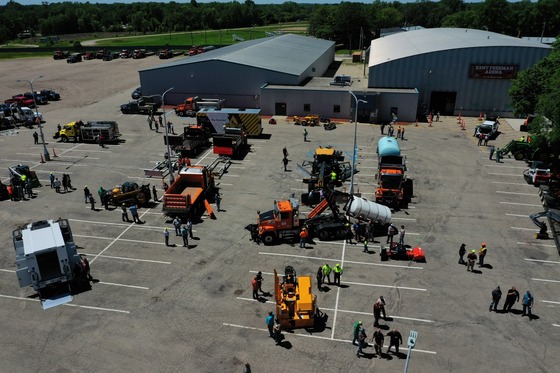
MnDOT is Excited to Support Local Communities With Public-Private Partnerships!
By Jessica Oh, Strategic Partnerships Director

MnDOT is excited to support local communities with public-private partnerships! On June 20, a new public space was unveiled under our bridges near Target Field—the North Loop Green. Enjoy green spaces, a stage, dining areas, and year-round events like movie nights, yoga, and festivals. The developer, Hines Corporation, invested in $5 million in public space improvements for the project, and they will perform operations and maintenance of the site through a 30 year airspace lease. MnDOT is increasingly receiving requests for these alternative uses of rights of way, and evaluating opportunities to leverage outside resources and maintenance capacity to support local goals. Policy expansions were required to achieve this project - MnDOT created new guidance in the Right of Way manual guiding commercial uses in Leases to realize this project. This unique project makes great use of underutilized space. Learn more about the North Loop Green and upcoming events.
|
Self-driving Shuttle Pilot Shows Promising Success, Extended for 24 Months!
By Thomas Johnson-Kaiser, Public Engagement Manager
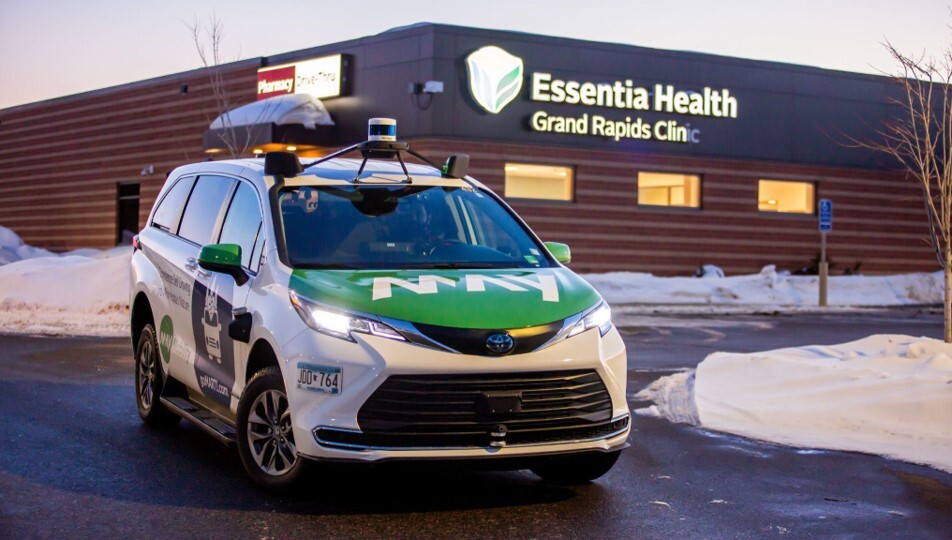 Phase 1 of the goMARTI self-driving shuttle pilot is coming to a close at the end of September after two years of operation. In addition to successfully providing more transportation options to the Grand Rapids community, the pilot resulted in many lessons learned including:
- Automated vehicle operators played an important role in communicating with passengers, sharing their expertise, and securing wheelchairs.
- Community engagement (such as meetings, surveys, and outreach events) and frequent updates to stops and routes allowed goMARTI to adapt and evolve in response to community feedback.
- A local presence and strong, engaged community can amplify and accelerate adoption. goMARTI ridership increased significantly almost a year into the pilot.
- Taking advantage of the Autonomous Driving Kit allowed for optimal performance in sunny summers and snowy winters.
- *Alt text
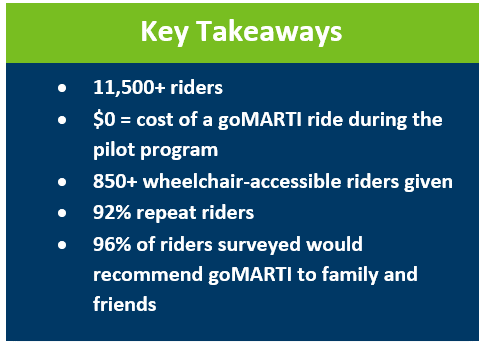
A more detailed policymaker summary of the project takeaways is available and a full project report will be completed in late 2024. To receive a copy when it’s available, subscribe of the project webpage. After phase 1 of the project comes to a close, phase 2 of goMARTI begins October 1, 2024. Last summer the USDOT announced that the goMARTI pilot project will be extended for three additional years and expanded within the City of Grand Rapids and to the neighboring communities of Cohasset and La Prairie with the help of a $9.3 million federal Advanced Transportation Technology and Innovation Program (ATTAIN) grant to the Department of Iron Range Resources & Rehabilitation. Goals for the expansion include providing increased access to essential services, improving accessibility, providing exposure to new technologies including electric vehicles, and conducting autonomous vehicle research in a rural environment.
|
MnDOT Launches Nation’s First Shared-Mobility Innovation Program
By Elliott McFadden, Greater Minnesota Shared Mobility Program Coordinator
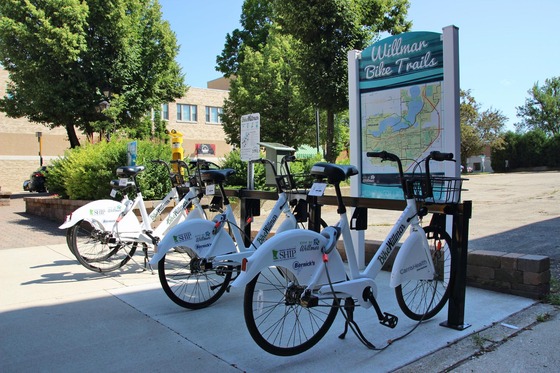 Image from BikeWillmar bike-share program
In July 2023, MnDOT launched the Moving Greater Minnesota Forward program, the first shared mobility innovation program in the nation that focuses on the unique needs of rural, tribal, and small urban communities. Shared mobility is any service where users share the service, either at the same time or individually. Examples of services used at the same time are public transit, ridehail, and van pools. Services that are used individually include carshare, bike and scooter share, and delivery services.
This innovation program provides assistance to projects in three phases. Phase 1 helps communities develop their idea from a general vision to a fundable project and works through a cohort of up to 12 projects every 6-months that meets collaboratively to develop and test their project. Any organization or individual with an idea for Greater Minnesota is eligible to apply. Projects that finish Phase 1 are eligible to apply for $500,000 annually in Phase 2 funding to implement their idea in a real-world pilot. Phase 3 focuses on scaling successful projects and works to match these projects with public and private funding sources to sustain growth.
Moving Greater Minnesota Forward helps our state by providing communities the technical and financial resources to create more transportation choices and helps MnDOT meet its public transit service and greenhouse gas emissions reduction goals. The program currently has 25 projects in development and 5 projects in pilot phase.
Development of a New Red-Light Running Warning System to Help Reduce Serious Crashes at Intersections
By Malee Yang, Research & Innovation Student Worker

Red light violations at signalized intersections can lead to serious injuries and fatalities. Intersections located in urban areas are most likely to result in angle-typed crashes from drivers running red lights. An ongoing LRRB-funded project led by Michael Levin, with the University of Minnesota, is testing a new kind of device using short-range communication receivers and GPS chips to see if the device can preemptively warn drivers to slow down as they approach a red light. Read more about the project and how the device operates here: Introducing a New Red-Light Running Warning System that can Potentially Reduce Human Errors at Intersections
|
Colorado Innovation Conference Session Recordings Now Available

Session recordings from the Colorado Innovation Conference 2024, hosted August 6-8, are now available online. This annual conference brings together industry professionals and experts to share insights on the latest trends, innovations, and challenges in the realm of operational excellence. The conference aims to inspire and increase state employees' ability and willingness to share and try bold new ways of doing their work, through learning relevant tools and methodologies.
|
Looking to get assistance with or share an innovation?

|